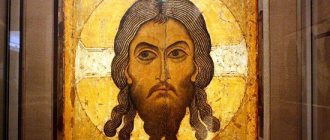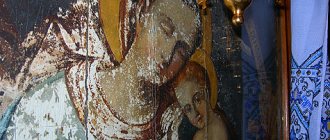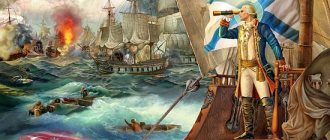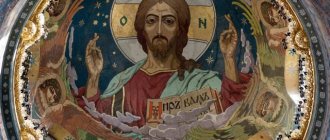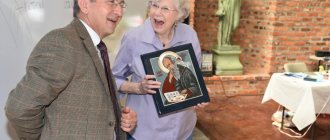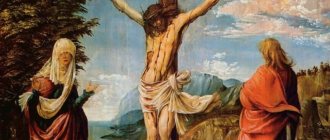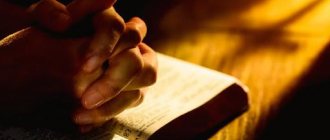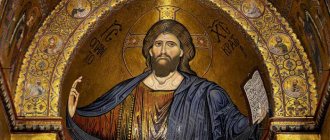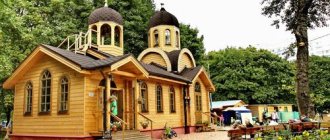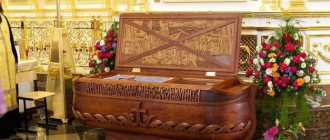Biographical information
Simon Ushakov is one of the few cultural figures of the 17th century whose biography can be established from surviving documents. It is reliably known that he was born in 1626 in the capital - Moscow. At birth the boy was named Pimen. This is proven by the artist’s characteristic signature: “Sovereign icon painter and Moscow nobleman sinner Pimin, nicknamed Simon Ushakov.”
Childhood and youth
There is no exact information about who Pimen’s parents were. But we can assume that they were fairly wealthy townspeople. From early childhood the boy was engaged in drawing, but there is no reliable information about the name of his teacher. It is worth thinking that he was one of the best Moscow painters. This proves that already at the age of 22 he received the status of master of the Silver Chamber under the Armory Order, granted by the tsar.
Main activities
The Last Supper of 1685.
The profession obliged the artist to sketch valuable household items located in the royal palace, paint military banners and create new ideas for patterns and embroideries. He also drew maps and plans of various territories, supervised the implementation of artistic works in palaces and temples. All the responsibilities that fell on the master’s shoulders with the beginning of his service as a sovereign allowed him to become closely acquainted with the culture and tradition of painting of his time.
In parallel with this, Ushakov was engaged in icon painting. It was icon painting that glorified the master. His work could be seen in all the major churches of that historical period. Simon Fedorovich's influence and recognition only grew when he was transferred to the Armory in 1664. Then he began to lead the rest of the royal craftsmen and personally restore important religious objects.
It is worth noting that Ushakov’s talent was also discovered in other arts, for example, in journalism. The large-scale work “A Word to the Careful Icon Painting” is his reaction to the first Russian theoretical treatise on art by Joseph Vladimirov. A significant part of the text is devoted to the main area of interest of Simon Fedorovich - icons. He talks quite expressively about the blasphemy of sacred images and their perception by man in general.
School of icon painters
Growing influence at court allowed Simon Ushakov to open his own school of icon painters. For that time, this was a big and bold step: he selected students personally, preferring the talented to the well-born. The school was under the patronage of Alexei Mikhailovich Romanov, the Tsar, under whose reign the icon painter worked. His descendants, Tsarevich Fyodor Alekseevich and Tsarevna Sofya Alekseevna, who later received power, were also loyal to her.
Last years
In recent years, Simon Ushakov carried out specific palace assignments - the main work fell on the shoulders of his students, the master himself dealt with only the most important orders. He died on June 25, 1686 in Moscow. By the standards of the 17th century, Simon Fedorovich lived a rather long and eventful life. And his legacy - both material and ideological - is significant for lovers of the culture of Eastern Christianity to this day.
In the Armory Chamber
In 1664, the hero of our article was transferred to serve in the Armory. The range of his responsibilities became wider, and his popularity only increased. He quickly became one of the best masters under the king, founding an entire school of icon painters.
Tsar Alexei Mikhailovich favored Ushakov and personally gave him all sorts of artistic assignments. Thanks to this, until his death, Ushakov lived in prosperity and honor.
He died in the Russian capital in 1686. He was 62 years old.
Significance in the history of Russian icon painting
Christ the Great Bishop 1658
The works of Simon Fedorovich Ushakov are contradictory. On the one hand, he tried hard to preserve the Byzantine tradition of icon painting. On the other hand, he quite boldly attracted new trends, which he borrowed and formed on the basis of those that came from Western European states.
The easiest way to understand the contrast of Ushakov’s actions is through specific examples. On the one hand, he used the prototypes of religion that were prayed for in Russia. On the other hand, he allowed himself to write them not according to the canons, but with the help of images from real life. Thus, it is believed that on the 1676 icon “Archangel Michael Trampling the Devil,” he depicted himself. Despite the fact that Ushakov painted only a person from himself, this is unthinkable for the icon painting of the 17th century.
Another uniqueness of Simon Ushakov’s works is that he began to use chiaroscuro. Still completely unnatural, it began to appear for the first time on his icons. Previously, the exposition was completely different - everything seemed to move in the opposite direction, showing the viewer that the action was taking place in an alternative world, the world of saints and Jesus.
Ushakov abandoned this idea, like his many Moscow students. With the help of his play with light, which comes not from the faces and figures themselves, but as if from outside, he began to bring the viewer and higher powers closer together. It is this rapprochement that is considered one of the artist’s main merits.
History of writing the icon
Simon Ushakov painted his famous icon in Moscow. “The Savior Not Made by Hands” appeared in the Trinity Church in the capital’s Nikitinki. It is noteworthy that the inscription at the bottom of this work has been preserved. It states that this work was created by the sovereign icon painter Simon Ushakov in 1658, 7166 from the creation of the world.
This inscription was updated in the 19th century. The icon “Savior Not Made by Hands” by Simon Ushakov is the very first image of the Savior Not Made by Hands that has survived to this day. It is known that Ushakov himself and the masters from his circle created more than one similar work.
It is worth noting that Simon Ushakov showed a certain innovation in this icon. “The Savior Not Made by Hands” was written in accordance with the most modern artistic techniques of the time. They determined the creative originality of Russian icon painting for many years.
This icon stands out from others not only by the natural rendering of facial features, but also by the light and shadow modeling of volume, created using a complex system in which dark and light tones alternated. In order to soften the transitions between them, at the final stage they were additionally adjusted to one another.
At the same time, it is worth noting that, unlike the European tradition, in the Russian icon the illumination of the saint’s face was in no way motivated by a real light source. And the location of the light highlights indicated that Ushakov and his comrades were observing a tradition that had existed in Russia since the 14th century.
Evaluation of Ushakov's icons
The opinion about the work of Simon Ushakov is quite controversial. Some critics consider him a person who did a lot to blur the boundaries between fine art and icon painting. Thus, the historian Georgy Filimonov stated that the significance of his artistic activity was to facilitate the transition from icon painting to painting.
Another famous Russian art historian and critic, Igor Grabar, shared a polar opinion. He argued that Ushakov’s role was not sufficient for a complete departure from the original Russian icon-painting traditions and the formation of new norms. However, all royal painters of the pre-Petrine era were subjected to the same strict criticism.
Modern researchers of Ushakov’s work share a similar opinion. Soviet and Russian historian of ancient Russian art Engelina Smirnova believes that the works of Simon Fedorovich are not evidence of any serious step towards a new artistic culture. She sees in them the preservation of the icon-painting rules of the late Middle Ages, and therefore adheres to the idea that the icons of Ushakov and his students are greatly overrated.
Creation
Quite a lot of icons by Ushakov have reached us, but some of them were distorted by later recordings and restorations. The best preserved icons of the Annunciation (Church of the Georgian Mother of God in Moscow), Our Lady of Vladimir with Moscow saints (ibid.), St. Theodore Stratilates (at the grave of Tsar Fyodor Alekseevich, in the Arkhangelsk Cathedral), the Savior Not Made by Hands (in the Cathedral of the Trinity-Sergius Lavra), the Descent of the Holy Spirit (ibid.), an icon-portrait of Tsars Mikhail Fedorovich and Alexei Mikhailovich (in the Arkhangelsk Cathedral). Ushakov's works indicate that he was a talented artist and had excellent command of the techniques of that time. His work was based on Russian-Byzantine icon painting, but he was also familiar with Western art. He invented new compositions, looked closely at Western models, and sought to give the figures individuality and dynamics.
Icon “Planting the Tree of the Russian State” (XVII century)
Simon Ushakov. Icon “Praise to the Vladimir Icon of the Mother of God” (“Planting the Tree of the Russian State”). 1668 State Tretyakov Gallery (Moscow) The Vladimir icon is depicted here as the main shrine of all Rus'. In the field of Orthodox iconography, Ushakov was not an innovator, with the exception of the icon “Praise to the Vladimir Icon of the Mother of God,” or, as it is also called, “Planting the Tree of the Russian State.” The image was painted for the iconostasis of the Trinity Church in Nikitniki, next to which the artist lived and was a parishioner. Behind the walls of the Moscow Kremlin is the Assumption Cathedral, from which a tree grows. In the center, among its branches and flowers, there is a medallion with the image of the Vladimir Icon of the Mother of God. At the foot of the Assumption Cathedral, Prince Ivan Kalita is depicted planting a tree and Metropolitan Peter watering the roots of a plant from a jug. On either side of them are the living royal family: Emperor Alexei Mikhailovich, his wife Maria Ilyinichna, sons Alexei and Fedor.
Tsarina Maria Ilyinichna with her sons Alexei and Fyodor. Detail of the icon “Planting the Tree of the Russian State” From the tree that grew in the center of the Moscow State, there are shoots in the form of vines with leaves, rose flowers and clusters of fruits. Its main fruits are the saints of the Russian land, depicted in twenty medallions with prayer scrolls in their hands. To the right of the icon of the Mother of God are the saints (Metropolitans Jonah, Alexy, Cyprian, Philip, Photius, Patriarchs Job and Philaret), as well as Tsars Fyodor Ivanovich, Mikhail Fedorovich and Tsarevich Dimitri. On the left are the monks Andronik of Moscow, Sergius and Nikon of Radonezh, Paphnutius Borovsky, as well as the Moscow holy fools Basil the Blessed, Maxim the Blessed and John the Great Cap. In the icon of Simon Ushakov, the tree is not genealogical, but spiritual. Their relationship lies in the fact that they are all saints of the Russian land. The Moscow Kremlin symbolizes the vertograd built by the Lord. The pious workers of Christ as the owner of the vineyard are Metropolitan Peter (1308-1326) and Ivan Kalita (1325-1340), with whose names the rise of Moscow is traditionally associated. Under Metropolitan Alexy, Prince Dimitri built the walls of the Kremlin, and under Metropolitan Cyprian, the icon of the Mother of God was transferred from Vladimir to the Assumption Cathedral (in 1395), which became its main shrine. This is how the rise of Moscow took place, its transformation into the capital city. The uniqueness of the icon “Planting the Tree of the Russian State” is that it reflects the united history of Rus' and the Russian Orthodox Church. Ushakov was primarily interested in the techniques of painting the faces of saints. He often assigned images of backgrounds and clothes to his students to paint. At the same time, for his works, Ushakov most often chose a simple background, for example, light blue: the icons “Our Lady of Kykkos”, “St. Sergius of Radonezh”, “Archangel Michael Trampling the Devil”. He created more than 12 images of the “Savior Not Made by Hands”. Constantly returning to this iconography, he tried to visibly convey the union of two natures in Christ: divine and human, to create images of the incarnate Lord, the God-man. The light in his icons comes from within the image, and not from the outside. Ushakov’s icons remain true Orthodox images. Ushakov’s writing style was called “life-likeness”: despite the great anatomical accuracy and emerging physical volume, the icons he created have the detachment, enamel smoothness and luminous power characteristic of the “heavenly world”. Ushakov was a versatile personality, he led a huge workshop, and at the same time he worked a lot himself. He was also a talented writer - he created a treatise on the art of painting, “A Word to the Inquisitive (lover) of Icon Painting,” in which he says that the Chief Artist is the Creator himself, who created and beautified the world: “Isn’t it the Lord himself who teaches us the art of icon painting? ?. In the treatise, he calls for the defense of the veneration of icons, discusses the relationship between the image and the prototype, and condemns the blasphemy of holy icons.
Icon "Archangel Michael trampling the devil"
Simon Ushakov “Archangel Michael trampling on the devil” (1676). State Tretyakov Gallery (Moscow) The icon has an unusual “rounding” soil. To the left and right of the archangel, the figures of selected saints are outlined in a pattern. In the lower left corner there is a man in a prayer pose, dressed in a townsman's dress and boots. Presumably, this is a self-portrait of the artist or a portrait of the customer of the icon.
Icon "Trinity"
Simon Ushakov “Trinity” (1671). State Russian Museum (St. Petersburg)
This icon of Ushakov echoes the famous icon of Andrei Rublev, repeating its composition, and also borrowing poses, gestures, and the pattern of folds on the clothes of angels. The prototype for the architectural rear view in a mirror image was an engraving from Paolo Veronese’s painting “The Feast in the House of Levi.”
Paolo Veronese “Feast in the House of Levi” At first the painting was called “The Last Supper,” but after the intervention of the Holy Inquisition, the artist gave the painting a new name.
Icon of the Mother of God “Kikskaya”
Simon Ushakov. Icon of the Mother of God “Kikskaya” from the Church of St. Gregory of Neocaesarea on Bolshaya Polyanka (1668). State Tretyakov Gallery (Moscow) Ushakov made this copy of the Kykkos (or Cyprus) icon of the Mother of God, which dates back to the miraculous image of the Hilandar monastery on Athos and was revered throughout the Greek East in the 16th-17th centuries. Many engravings were made based on Ushakov’s drawings. They are distinguished by their boldness in conveying space built on several plans. In the engraving depicting King David, Ushakov again uses the architectural background from Veronese’s painting, and in the engraving depicting Prince Joasaph in the window, a landscape with a palace and a geometric park in front of it is depicted.
Barlaam's conversation with Prince Joasaph. Illustration for the book “The Story of Barlaam and Joasaph” by Simeon of Polotsk. Drawing by Simon Ushakov. Engraving by Afanasy Trukhmensky (1681) The Last Supper is the subject of many icons and paintings, of which the most famous work is “The Last Supper” by Leonardo da Vinci. The Last Supper is the last meal of Jesus Christ with his twelve closest disciples (apostles), during which He established the sacrament of the Eucharist, taught the commandments of humility and Christian love, predicted the betrayal of one of the disciples and the future destinies of the Christian church and the whole world. This plot worried many artists: from Leonardo da Vinci to Salvador Dali. Ushakov also addressed this topic.
Simon Ushakov "The Last Supper"
The significance of Simon Ushakov's creativity
Nowadays, the name of Ushakov is not as well known to a wide circle of lovers of Russian icon painting as the names of Rublev and Dionysius. The icons he painted are scattered across numerous museums and private collections. At the end of the 17th and beginning of the 18th centuries. he had many imitators.
Simon Ushakov “The Savior Not Made by Hands” (1658). State Tretyakov Gallery (Moscow). Written for the Trinity-Sergius Lavra. His students replicated the images of the “Savior Not Made by Hands” in the manner of the master, but none of them managed to achieve the imagery and virtuosity inherent in his brush. His art was innovative in terms of writing technique, in the search for new visual means and a new look at icon painting, so his art will forever remain relevant for those painters who are constantly in search of a new artistic language, who are not limited to template copying of ancient images, but are looking for new ones creative ways.
- < Back
- Forward >
How does the icon “Savior Not Made by Hands” help?
The great image of Jesus Christ can become a faithful protector of people, but for this you need to establish a prayer dialogue with him. If you are interested in what the “Savior Not Made by Hands” icon protects from, then it is worth knowing that it protects against numerous diseases and various negativity directed at a person from the outside. In addition, you should pray in front of the image for the salvation of the soul, for loved ones and children. Sincere appeals will help improve your well-being, find a job and cope with various worldly affairs.
Prayer “To the Savior Not Made by Hands”
You can address the image in your own words, the main thing is to do it from the heart. The simplest prayer that every believer knows is “Our Father.” It was given to people by Jesus himself during his earthly life. There is another simple prayer, “To the Savior Not Made by Hands,” the text of which is presented below. Read it every day at any time when your heart requires it.
“Savior Not Made by Hands” – origin story
Many people wondered where the image of Christ’s face came from, if nothing is said about it in the Bible, and the church tradition retained a minimum of descriptions of appearance? The history of the icon “Savior Not Made by Hands” indicates that details about the face were conveyed to people by the Roman historian Eusebius. The ruler of the city of Edessa, Abgar, was seriously ill, and he sent an artist to Christ to paint his portrait. He was unable to complete the task because he was blinded by the divine radiance.
Then Jesus took the linen (ubrus) and wiped his face with it. A miracle happened here - the imprint of the face was transferred to the matter. The image is called “miraculous” because it was not created by human hands. This is how the icon called “Savior Not Made by Hands” appeared. The artist took the fabric with the face to the king, who, taking it in his hands, was healed. Since that time, the image has created many miracles and continues to do so to this day.
